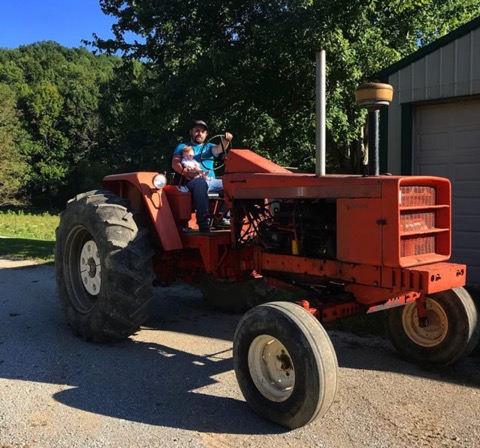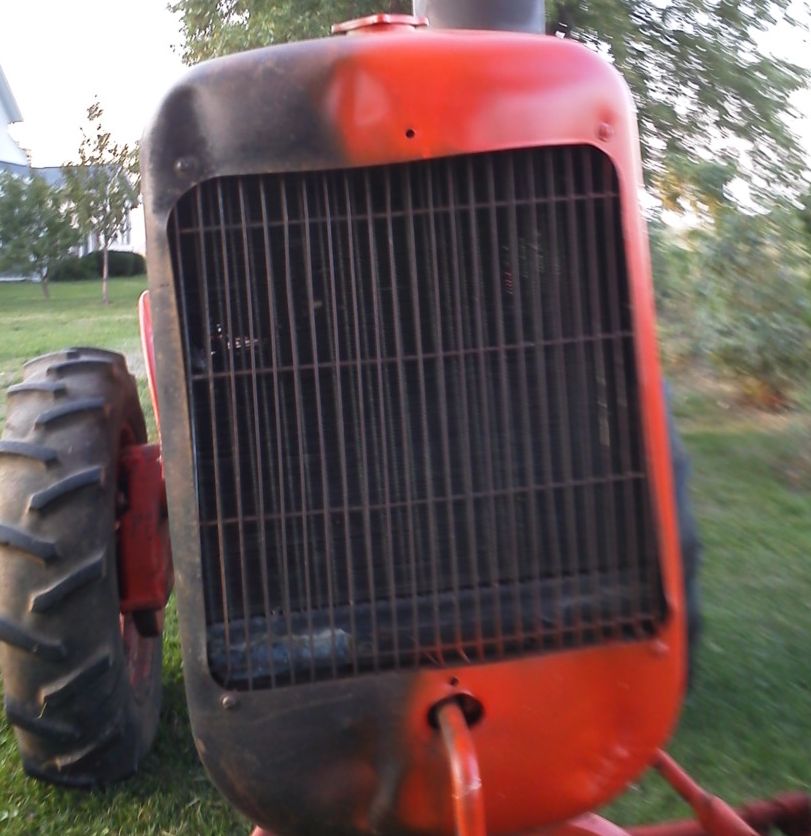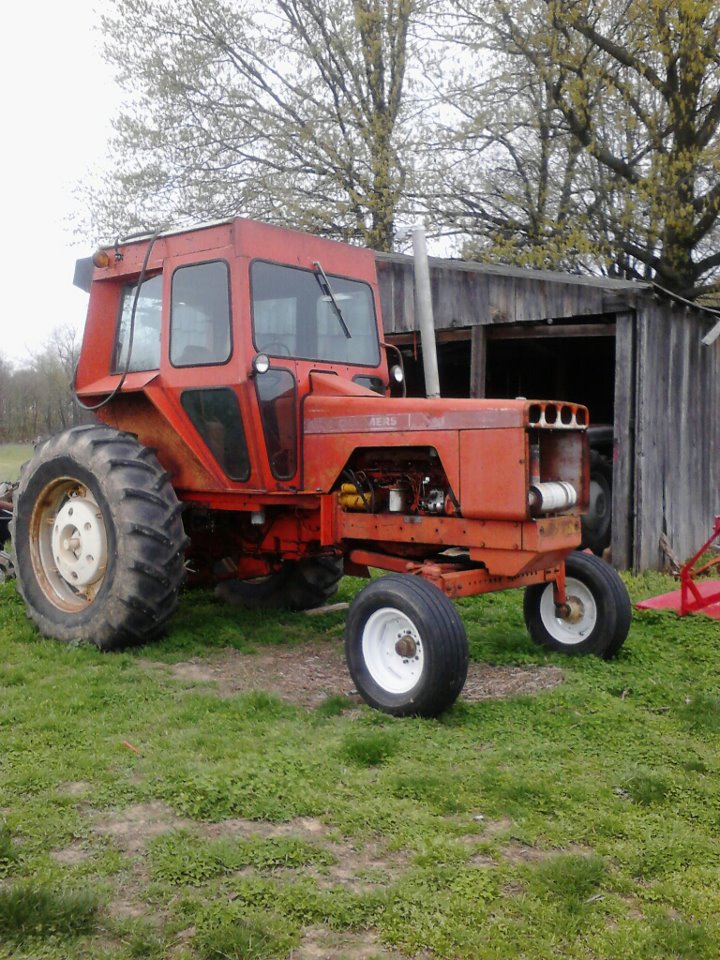| Author |
 Topic Search Topic Search  Topic Options Topic Options
|
AllisChalmers37 
Orange Level


Joined: 11 Jul 2010
Location: London,KY
Points: 1846
|
 Post Options Post Options
 Thanks(0) Thanks(0)
 Quote Quote  Reply Reply
 Topic: Running LP Tractors Topic: Running LP Tractors
Posted: 18 Aug 2012 at 11:03pm |
With today's crazy gas and diesel prices I was wondering if it was a reasonable idea to run LP? This of course would mean that I would need another tractor  Anyway, I was wondering if it is a good idea to look for an LP tractor or if the savings in fuel wouldn't be worth the trouble. I know that LP makes slightly less power than gasoline but LP also burns alot cleaner and the engine lasts longer. Here at home farm diesel is around $3.50 per gallon and LP is $1.69 per gallon. So I was just tossing around the idea to myself and was wanting some input from you guys. Thanks, Jeremy
|
|
1937 WC, 1950 CA, 1959 D14, 1967 190XT, 2006 Ram 3500
|
 |
|
Sponsored Links
|
|
 |
rtwfarm 
Orange Level

Joined: 26 Feb 2012
Location: nebraska
Points: 1324
|
 Post Options Post Options
 Thanks(0) Thanks(0)
 Quote Quote  Reply Reply
 Posted: 19 Aug 2012 at 2:30am Posted: 19 Aug 2012 at 2:30am |
|
Have 2 d17 propane for sale. Ryan 402-469-1738
|
 |
CTuckerNWIL 
Orange Level


Joined: 11 Sep 2009
Location: NW Illinois
Points: 22825
|
 Post Options Post Options
 Thanks(0) Thanks(0)
 Quote Quote  Reply Reply
 Posted: 19 Aug 2012 at 9:01am Posted: 19 Aug 2012 at 9:01am |
|
I think the investment would pay off quicker if you have a "true" lp engine with higher compression ratio instead of a dual fuel engine that can get by on either. They definitely stay cleaner way longer inside.
|
|
|
 |
Byron WC in SW Wi 
Orange Level


Joined: 11 Sep 2009
Location: Wisconsin
Points: 1635
|
 Post Options Post Options
 Thanks(0) Thanks(0)
 Quote Quote  Reply Reply
 Posted: 19 Aug 2012 at 9:09am Posted: 19 Aug 2012 at 9:09am |
|
I've thought about it too but my spin is that I wonder if you can have a methane digester and have the tractor run on methane.
|
 |
Byron WC in SW Wi 
Orange Level


Joined: 11 Sep 2009
Location: Wisconsin
Points: 1635
|
 Post Options Post Options
 Thanks(0) Thanks(0)
 Quote Quote  Reply Reply
 Posted: 19 Aug 2012 at 9:19am Posted: 19 Aug 2012 at 9:19am |
Just found this. I didn't realize natural gas was mostly methane.
|
 |
wood 
Orange Level


Joined: 15 Sep 2009
Location: alabama
Points: 291
|
 Post Options Post Options
 Thanks(0) Thanks(0)
 Quote Quote  Reply Reply
 Posted: 19 Aug 2012 at 9:21am Posted: 19 Aug 2012 at 9:21am |
|
I run a WD45 lp as a chore tractor. I think that LP will be back on more Automobiles and tractors. The way our fuel production is going, we have a great supply of LP. You speak of a LP not having the HP as a Diesel. A 190 LP will pull the same plows as a 190 diesel. In twenty years you will see LP tractors in the field again.
|
 |
DaveKamp 
Orange Level Access


Joined: 12 Apr 2010
Location: LeClaire, Ia
Points: 6089
|
 Post Options Post Options
 Thanks(0) Thanks(0)
 Quote Quote  Reply Reply
 Posted: 19 Aug 2012 at 10:06am Posted: 19 Aug 2012 at 10:06am |
|
My propane contract price for this winter came out to under $1.20. Yield forecasts are low as a result of drought... this is a double-whammy to the propane market, because there's be fewer bushels to dry, and they'll be pretty dry to start with. Top that off with the fact that propane is a byproduct of petroleum refining (so it has to go somewhere), it makes it very inexpensive right now. I hate to say it, but I'll take it... any break we can get, I'll take.
The equivalent methane fueling concept would be CNG, and it IS making a comeback as a result of large investment by some major privately owned distributors... they've been installing cng pressure booster/condenser systems that allow NG pipelines to feed dispensers at truckstops. The biggest economic concern about bottled gases, is availability. The biggest convenience concern, is filling equipment. The biggest safety concern is the containment pressure.
At ambient pressure, diesel fuels evaporate as very high temperatures... Somewhere in excess of 300F or so.
Gasolines evaporate more in the vicinity of 20F and up.
Propane boils down around -15F
NG boils around -200ish or so.
In order to contain diesel, you put it in a barrel... it won't evaporate off.
Same for gasoline... a little will evap, but not fast, particularly if the fuel containment system has a ventless cap and evaporative recovery (california emmissions)
In order to contain propane, you'll need an ASME-compliant containment vessel, and it'll be suitable for 250psi or so test pressure.
To contain CNG that's been liquified, you're looking at an ASME-compliant vessel in the 3500psi range.
And if you plan on taking any of those pressure-containment vessels on the road, it must be DOT compliant, too...
So it's kinda like what we deal with in steam tractors and steam locomotives... Everything old is new again.
But back to tractors...
Propane and LCNG have several things in common... first is that they're never delivered into the intake as a liquid (at least... nobody's doing that yet)... second, is that since they're in a sealed, pressurized container, they tend not to become contaminated or go 'bad'. (Gasoline distributors swear that gasoline 'can't go bad'... well, I've never found a can that would restrain it well enough to prevent condensation or tank corrosion from contaminating the fuel, and I've never found ethanol-blended motor fuels that wouldn't settle if you left them in a jar on a shelf for two weeks... that, plus the fact that the higher-volatility compounds in 'gasoline' evaporate out, leaving you with a 'gunky' mess... especially in a carbeurator bowl... suggests that gasoline isn't quite as environmentally-inert as marketers insist. Propane and LCNG, however, are sealed in TIGHT.
Yes, LCNG is 'methane'... actually, it's a conglomeration of whatever came out of the wellhead. It's not as consistent as propane, and every so often, it comes through the pipeline with 'air bubbles' or sometimes bubbles of 'odorant', rather than natural gas... this can cause flame-outs on furnaces, water heaters, stoves, etc., and when compressed, well, it has it's own set of properties. Not a big deal, but since it's coming through a pipeline, it does happen.
Propane comes in two, 'grades'... HD5 and HD10... HD5 is considered 'consumer grade', which is the purest rating... HD10 is considered 'commercial grade', which means it's allowed to contain up to 10% propylene (a plastics manufacturing byproduct). The presence of higher amounts of propylene causes some gumming-up problems with engines, but it's fine for heating and cutting purposes. I've never seen anything other than HD5 from my supplier, and not only does my furnace and water heater run off my farm tanks, my three generators (small, medium, and really large) run off of 'em too.
As the other guys noted, you could CONVERT your gasoline tractor to propane, but it would be a better deal all around to have a second tractor that was fitted with the propane system from the git-go... partially because you have the higher compression, with the evaporator/regulator/mixer and tank installation all figured out... plus... a man always needs to have a second (or third... or fourth... or) tractor.
A properly setup propane-powered tractor will have every bit of it's power capacity available... the only difference being that the propane you burn will have less energy per unit volume of the gasoline or diesel motor... so you'll use more fuel for a given task. Considering the cost offset, it may be substantially less expensive to run one over the other.
I run my generators on propane, but it's not primarily for cost reasons. While the propane costs are lower right now, they're not always that way. Typically, the cost offset favors propane, but the real reason, is because I have several large tanks that always have plenty of fuel in them, and when our power goes out, the conditions are frequently such that driving to a gas station to fill fuel cans is not possible... we're snow/iced in... furthermore, if the storm is really bad (and takes out substations), if we were able to get to town, we still wouldn't be able to fuel.
|
 |
Dipstick In 
Orange Level


Joined: 11 Sep 2009
Location: Remington, In.
Points: 8602
|
 Post Options Post Options
 Thanks(0) Thanks(0)
 Quote Quote  Reply Reply
 Posted: 19 Aug 2012 at 10:08am Posted: 19 Aug 2012 at 10:08am |
Many years ago Bob Gretencord was the MM dealer at Remington, In. He was famous in the area for making "STRONG" Minnies, and getting horsepower out of the other brands. The Remington area, sitting on US 24 is a good divider between heavy black, prairie dirt to the south, and a combo of sand hills and heavy dirt to the north. M's to the south pulled 2 bottom plows, and to the north of 24, would generally pull a 3-14" plow. Most of his customers were in the black dirt south of town. There are many secrets that died when Bob passed away, but some of the things known are that a Moline can have the "jugs"(the cylinders) replaced with larger bores, and different cranks(off the shelf) can be installed, different heads are available to raise compression. And of course carbs, or maybe more correctly, mixing chambers can be replaced, along with dry air filters vs. oil baths. I had one of Bob's G-1000's for a while. It must have been putting out in the neighborhood of 135 hp, based on the way it pulled my chisel plow! That from a 108 hp factory tractor. I had an Oliver 1855 with a 1955 motor at the time and I hooked that chisel to it one year. You know, nicer cab, easier driving, diesel vs. slow filling with LP, etc. I drove to the field and dropped the plow in the dirt, and instantly spun out, trying to raise the plow to pull it, I found a spot where I had traction, and killed the motor!!! This was with 119 dynoed horsepower. So I headed back to the house and switched tractors. I did not have a tractor that would pull that plow until I got my 7060!
Horsepower is avilable with LP, and can be had! Dave Stangle campaigned his "Solid Junk" G1000 for several years and was very competitve with Red, Green, Orange, and all the rest in the unlimited classes. He never had real competition until the advent of the turbine engines!
Depending on who's numbers you use, LP is in the 100-120 octane range, and yes, there is a slight "give-away" in power, but like diesel, with higher compression and a healthy slug of gas, power can and will be made with it.
My G-1000 had the factory 30-35 gallon tank, and mounted on a platform in front of the radiator was another tank. If I filled both tanks, some 60 gallons, I was good to go for all day, until suppertime when I had to fill again. Fuel was cheap, and I had work to do so economy wasn't the big concern it is today.
Hope this gives you some answers to questions 37, like the other guys said it can work for you! joe
|
|
You don't really have to be smart if you know who is!
|
 |
Dipstick In 
Orange Level


Joined: 11 Sep 2009
Location: Remington, In.
Points: 8602
|
 Post Options Post Options
 Thanks(0) Thanks(0)
 Quote Quote  Reply Reply
 Posted: 19 Aug 2012 at 10:22am Posted: 19 Aug 2012 at 10:22am |
|
Dave that was a really good article on the gasses. You spelled out some things that I wasn't aware of, particularly on CNG. There are several dairies in the middle-north of our county, and they are experimenting with digesters and methane. The milk trucks( right now contracted to Ruan) are being run on CNG from a fueling station near their terminal/filling area. One of the problems is that it is 220 miles to Louisville, Ky. one of their delivery points,and they hold just enough gas to get there and back, usually! they have kept several tow trucks busy bringing tankers back when a wind was blowing the wrong way, orrrrr the driver or equipment malfunctioned and didn't supply enough gallonage. New technology doesn't always come cheap! 10-4?
|
|
You don't really have to be smart if you know who is!
|
 |
Byron WC in SW Wi 
Orange Level


Joined: 11 Sep 2009
Location: Wisconsin
Points: 1635
|
 Post Options Post Options
 Thanks(0) Thanks(0)
 Quote Quote  Reply Reply
 Posted: 20 Aug 2012 at 7:37am Posted: 20 Aug 2012 at 7:37am |
Dave,
Really good info thanks for sharing.
|
 |
Sandknob 
Orange Level


Joined: 12 Sep 2009
Location: Oblong, IL
Points: 2456
|
 Post Options Post Options
 Thanks(0) Thanks(0)
 Quote Quote  Reply Reply
 Posted: 20 Aug 2012 at 8:31am Posted: 20 Aug 2012 at 8:31am |
Dave, Great info, but to add one small correction. There is a manufacturer that is making a liquid injected engine now. That would be the Ford "Rousch" propane vehicles (F150/250/350, E150/250/350 and a few other models I believe). Thanks Adam
|
 |
Dipstick In 
Orange Level


Joined: 11 Sep 2009
Location: Remington, In.
Points: 8602
|
 Post Options Post Options
 Thanks(0) Thanks(0)
 Quote Quote  Reply Reply
 Posted: 20 Aug 2012 at 8:40am Posted: 20 Aug 2012 at 8:40am |
|
Sandknob I wonder about those milk trucks, but the only driver I found to talk to didn't know whether the trucks ran on vapor or liquid injection. They are all Kenworths, class 8's and sound almost like a diesel engine. They do seem to run with all the rest of the trucks as far as power goes.
|
|
You don't really have to be smart if you know who is!
|
 |
DaveKamp 
Orange Level Access


Joined: 12 Apr 2010
Location: LeClaire, Ia
Points: 6089
|
 Post Options Post Options
 Thanks(0) Thanks(0)
 Quote Quote  Reply Reply
 Posted: 20 Aug 2012 at 10:20am Posted: 20 Aug 2012 at 10:20am |
|
There have been quite a few experiments with direct injection of compressed-liquified fuels... actually, they went back many, many years... mechanical injection systems like what diesels use, and they were vexed by a myriad of little challenges... they seem to have overcome most of the challenges... modern technology of electronic injection control helped lots of it, some other advancements in injector design, ceramics, lower costs of some alloys, and other stuff have helped. Keep in mind that while we frequently refer to 'diesel' engines as burning 'diesel fuel'... the 'Diesel' cycle is really just a type of ignition system that uses principle of compression-ignition, rather than spark. There've been direct-injection LP systems in stationary engines for quite some time... the first ones that I'm aware of, were port-fuel injection, with spark igntion, but I know there's quite a few diesel standby units that use LP. The biggest crux of all of them, it seems, is the fact that the LP/LCNG injector is even more finicky than a diesel injector, and because of the evap point, has the propensity to do much more crazy stuff in operation... but the side effect, is that if you're blowing LCNG through that nozzle, the evaporating fuel will help cool the tip. I applaud the engineers and technicians that make it work- they're tackling a difficult, but very honorable job.
LCNG and LP can be burned in either, but as with ANY engine and fuel, the engine's mechanical characteristics must be tailored to suit the combustion characteristics of the fuel- some fuels burn faster, some slower, some with greater heat output, some with less. The INTERNAL COMBUSTION ENGINE's function, is to turn the HEAT, into mechanical energy. With each fuel type having it's own particular burning properties, this all translates into a need for different engine design to get the most mechanical energy out of the fuel used.
John Deere put lots of development capital into their diesel CNG engines. Our local bus authority has two dozen CNG busses and their own booster/condenser system. When they first considered CNG, they had several different manufacturers bring in busses fitted with CNG systems... many were running 'conversions', where the engine was essentially stock. I believe the Deere engine was developed on a platform similar to their other engines (i.e. using same block, bore spacings, etc.,), but the rest of the engine was addressed as a 'clean slate' concept based on the CNG's burn character. I DO know, that when standing alongside the running busses, every one of them sounded like a diesel engine, except the Deere... sounded like it was spark-ignition... and the report I got from the assessment drivers, is that all the diesels felt like diesels, with the exception that it felt like the turbos were not generating boost (even though they were)... while the Deere was snappier than even their normal diesels, didn't exhibit turbo lag, and didn't shake the bus like an oil burner.
So we ended up with a bunch of the JD LCNG diesels. Now, I haven't talked to my buddy at the bus barn in a year or so, but last time I did, they'd had about 5 years on the CNG motors, and no substantial failures to date. I think they've had to work on the booster/condenser a bit during the first year of operation, but they apparently got that all ironed out.
I do know that the fuel consumption of the LCNG busses is higher, just like an LP-fueled engine will be higher than diesel or gasoline... reason is simple- fuel energy density. A gallon of diesel is good for about 139,000btu. A gallon of gasoline is around 125,000btu... liquid propane is around 91,500 for a GALLON... and when evaporated, it comes out to 2500btu per cubic foot. Natural Gas comes out to about 1050btu/cubic foot.
So... you can expect that for every gallon of diesel burned, you'd need about 1.1 gallons of gasoline, 1.51 gallons of liquid propane, and 3.6 gallons of LCNG... that is... as long as each engine used, is built and optimized for that particular fuel.
Many guys will dismiss using other fuels as being sub-grade, it really just comes down to comparing fruit. Most people love walnuts and celery, but very few people I know like walnuts and celery in orange jello.
|
 |
DaveKamp 
Orange Level Access


Joined: 12 Apr 2010
Location: LeClaire, Ia
Points: 6089
|
 Post Options Post Options
 Thanks(0) Thanks(0)
 Quote Quote  Reply Reply
 Posted: 20 Aug 2012 at 10:56am Posted: 20 Aug 2012 at 10:56am |
|
For Jeremy's original question:
One can easily set up a spark-ignition engine to RUN on propane... even if that engine is not originally built to suit the fuel burn character of propane, it'll do it just fine- Without modifying the internals, but adjusting ignition timing, you'll have a little loss in output, but the cost of fuel will make the pain in your back pocket much, much lower, and ease the pain under your throttle lever much less.
There's some basic components to the LP conversion system, and they all revolve around simple-principles that exist in gasoline engines... it's just that the fuel's character makes things happen in a different way.
Propane tanks have two types of withdrawal systems- liquid (off the bottom) and vaporous (off the top). Your gas grill runs off vapor... and if you have a big grain dryer, it most likely draws off liquid. Difference being, when you pull a gallon of liquid through a small line, you're still moving LOTS of energy. When you pull vapor off the top, it takes more VOLUME to get the equivalent energy.
Liquified gaseous fuels don't WANT to be a liquid- they want to boil at ambient temps... (except one gotcha I'll note later). This means that if you open up the gaseous withdrawl, you'll blast gaseous propane into the sky. If you open up the liquid withdrawl tube, you'll have a massive geyser of liquid shooting straight up, and then evaporating. BOTH scenarios are rediculously deadly, so please don't do it. You're essentially messing with a steam engine here, but the steam is really, really, really flammable.
Okay, so in a vaporous withdrawl, you have a tank which has pressure in it, you'll feeding a 'first stage' regulator that drops the tank pressure (on propane, anywhere from near zero, to up to 250psi or so) and holding it around 3psi or so. That goes through your transport plumbing, to a 'Second Stage' regulator at the USE point, typically drops it down to a pressure of about 11" Water Column (much lower than 1psi... just enough to raise the water level in a tube by 11 inches, and yes, you can make a WC manometer at home, with clear plastic hose, some water, and a permanent marker!).
So it's down to 11" WC. Now it comes to the engine, where it needs to be fed to the engine in a variable state, to match engine demand.
There's also a gadget that introduces the vapor into the airstream, and mixes it with oxygen so it'll burn.
The gadget is called a 'mixer', and sometimes, it's a dedicated device (like a carbeurator, or an added device before, or after a carbeurator)...
And then there's some way for the fuel flow to be controlled.
In a liquid fuel carbeurator, fuel sits in a bowl, and when airflow occurs through the venturi, the pressure difference (vacuum) draws fuel up through the jet, where it sprays (atomizes, evaporates) and mixes with air.
Propane, in a vaporous system, is already evaporated... we just need a way to CONTROL it. Some 'Mixers' have a mechanical technique for varying fuel flow based on airflow... a plate or something sitting IN the airflow path, that as air flows, it lifts the plate, which operates the fuel metering valve. IMPCO CA-series comes to mind here...
There are other techniques for introducing fuel and metering... one is drilling a hole in the bottom of the carbeurator or into the manifold, and just feeding the fuel in... (frequently called stub-in) and using some OTHER method to control fuel flow. One of the methods, is by using something called a 'demand regulator', which takes in the 11"wc vapor, and monitors vacuum at the mixer or stub-in, and the DR does all the dirty work, just feeds it in as vacuum demands it. Slick gadget.
Now, for LIQUID delivery, the same concepts apply... out of the tank, through first stage regulation (different part, but same concept... all about safety), then into a gadget called an 'evaporator'... basically a snail-shell shaped vortex that has a water jacket around it, wherin engine coolant circulates to cause the liquid to boil to vapor. Oftentimes, the first stage reg and evaporator are the same thing. From there, it's a high-volume vapor, so on to the engine just like the vapor-based.
The 'gotcha', is that with LP, it's boiling point is down around -20F or so. If you watch the pressure gauge of your home tank, you'll see that even if you NEVER use the tank, the pressure inside varies. On a hot day, it'll hit 250psi or so (pressure relief valve will pop off a bit when that happens)... on a really cold day, it may drop darned-well zero. In order to get vapors to flow, there needs to be SOME pressure... if there is no pressure, there'll be no flow.
If you're doing vaporous withdrawl, and only have say... 4psi to work with, you'll have 4psi with a substantial restriction flowing through the plumbing to your load. If you're doing liquid withdrawl, you'll have that same 4psi, and perhaps a little more restriction because you're pushing liquid... but the amount of VOLUME you're pushing through is essentially same regardless of vapor or liquid, but with LIQUID, you have substantially more energy coming through with unit volume, than you would vapor. This is why bigger engines are liquid-fed... they evaporate JUST before the mixer.
Here's another gotcha: When your tank is totally full, there's very little space at the top of the tank for the propane to 'boil' to vapor. This is one of the reasons why you don't want the tank to be filled over 80%. NExt, if you're using a very small tank, there will be very little surface area in that tank from which it can boil, and as a result, the tank will get very, very cold, and the propane will stop boiling.
This 'cold'... is Boyle's Law (Combined Gas Law) at work. (Pressure = Volume)/Temperature. Basic concept: When you compress a gas, it gets hot. When you discharge a compressed gas, it gets cold.
Demonstration: Place your hand on the outlet pipe of your compressor while it's running. Place hand in your mouth, because it hurts, and notice- your skin tastes very warm. This is because the compressor is taking a big volume of air, and cramming it into a small space. The ambient heat energy of all that air, is being 'squashed in', and hence, is trying to get out. Compressor's intercooler and aftercooler help improve compressor efficiency (and lifespan) by giving that heat a very quick path out of the air... and it also helps dry the air... but that's next week's lesson)
Now, allow compressor to shut off, and open air-hose at other end of compressor tank, and let it blow. Hold onto that nozzle, and notice that, even though it's 85F in the shop, that nozzle is starting to develop frost. That is because the expanding air is PULLING HEAT from the area around it...
Now, if the air temperature was low enough, even with that tank pumped up to full pressure... cool it SO FAR that the air pressure in the tank would drop so low, that opening the valve would NOT result in much airflow coming out... it just sits there.
Propane, when in liquid form, will want to STAY liquid below -35f... and it will impart NO pressure on the lines... so you'll have NO fuel flow. In effect, it'll be just like gasoline... it'll stay a liquid.
Sucks when it's -35 in the midwest on a really, really cold night... and there's not enough pressure in the propane lines to keep the furnace burning. Grandpa's trick times when it was too cold to develop pressure... build a little snowbank around the up-wind side of the propane tank, and place a can of STERNO under the tank... keep the flame no closer than about 3-4", and it'll warm it enough to get pressure to build... not alot, but enough.
So there's your propane-engine primer for the day.
|
 |
Dwayne TX 
Silver Level

Joined: 11 Sep 2009
Location: Texas
Points: 221
|
 Post Options Post Options
 Thanks(0) Thanks(0)
 Quote Quote  Reply Reply
 Posted: 20 Aug 2012 at 11:55am Posted: 20 Aug 2012 at 11:55am |
|
To answer your original question - I run 3 LP tractors, a 190XT, D19, and WD. When I first got the WD, it hadn't run in a while and took the valve cover off to make sure the valves were not stuck. The whole valve train was clean as a whistle, so that says something about propane. I don't do any heavy tillage with any of them, so I don't see a lack of power or excessive fuel use. The thing I really like is propane won't go sour like today's gasoline. Hard to beat fuel at 1/2 the price of diesel, too. Find a full-service propane dealer (especially if they're old-timers) and they will be a wealth of knowledge and advice, because you'll probably have issues with valves, regulators, or carbs on a 30+ year old system. A wet line on your propane tank will be needed to fuel your tractor. Oh and a good pair of gloves as propane isn't compatible with skin.
|
 |
MikeinLcoMo 
Orange Level


Joined: 12 Sep 2009
Location: west plains mo
Points: 620
|
 Post Options Post Options
 Thanks(0) Thanks(0)
 Quote Quote  Reply Reply
 Posted: 20 Aug 2012 at 1:10pm Posted: 20 Aug 2012 at 1:10pm |
|
I have heard that LPG stores well with no deteriration in long storage periods. Any fact to this? Mike
|
 |
Ted in NE-OH 
Orange Level


Joined: 12 Nov 2009
Location: Austinburg OH
Points: 1703
|
 Post Options Post Options
 Thanks(0) Thanks(0)
 Quote Quote  Reply Reply
 Posted: 20 Aug 2012 at 4:49pm Posted: 20 Aug 2012 at 4:49pm |
|
Yup. It is in a sealed container, can't evaporate and can not oxidize.
|
|
CA, WD, C, 3 Bs, 2 Gs, WC, I-400, 914
|
 |









 Topic Options
Topic Options


 Post Options
Post Options Thanks(0)
Thanks(0)







